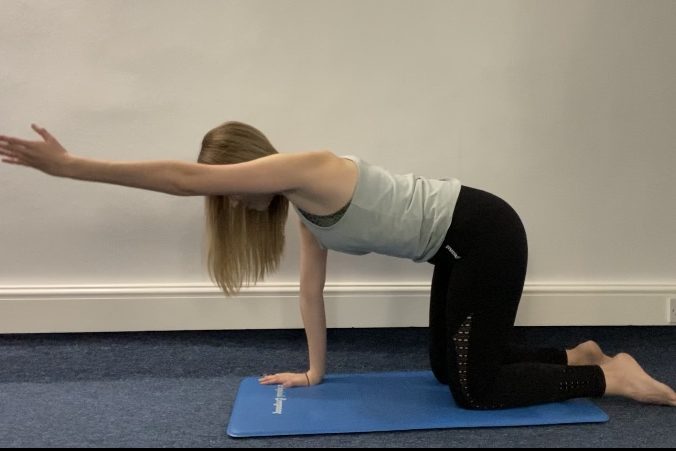Strengthening your body during pregnancy has multiple benefits including reducing the risk of low back and pelvic pain.
See our blog ‘Safe exercise in pregnancy’ to see all of the benefits of exercise and things to consider prior to exercise.
Look at four core exercises here on video to strengthen your core to help you get started.
**If your pregnancy is being treated as high risk or you have any concerns, please contact your obstetrician or midwife before starting any exercise programme.
BUMP LIFTS – TABLE TOP ON HANDS AND KNEES
During pregnancy the ‘6 pack’ muscles (Rectus Abdomini) separate and move to the side to allow the baby to grow. This exercise targets the deep tummy muscles that are vital to support the bump and the pelvis during pregnancy. Start on all fours with your hands underneath your shoulders, your knees under your hips and your spine in a neutral position.
As you breath out, activate your pelvic floor muscles by squeezing around the back passage, then pull your belly button towards your spine. You should feel the bump moving away from the ground. As you breath in relax your abdominals and pelvic floor muscles.


**Tips – make sure your back stays level and you keep looking down to your hands
BIRD DOG
If you have mastered bump lifts and want to progress, bird dog is a great exercise to incorporate leg and arm strengthening whilst also challenging your balance and core.
Start with a bump lift, and whilst you squeeze, extend your leg out behind you (not higher than your buttocks), and lift your arm up so both are in line with your trunk. As you breath in, lower your limbs back to the ground and relax


**Tip – find this one too challenging? Try just lifting a leg or an arm rather than both. Or slide your foot along the floor to help you balance.


SQUATS
Squats are a great exercise to strengthen both the buttocks which help to stabilise the pelvis during pregnancy. Start in a standing position, activate your pelvic floor and core muscles and bend your hips and your knees as through you are going to sit in a chair. Keep your spine in a neutral position. Return to standing by squeezing your buttocks together.




**Tip – If you feel unsteady as the bumps grows, put a chair behind you and turn squats into ‘sit to stands’. If your ankles limit your range within your squat, try putting a book under your heels (only if you have enough balance!)
LOW TO HIGH KNEELING
Start in a kneeling position. As you breathe out, activate your pelvic floor muscles and bring your belly button towards your spine. Slowly rise to a high kneeling position focusing on activating your pelvic floor muscles, abdominal muscles and glutes. Slowly return to your starting position. To make it harder, raise your arms as you lift up and lower them as you lower, aiming to keep your trunk stable (and avoid overarching).



Need more Advice to help you through your pregnancy?
Getting a full pregnancy assessment by a women’s health physiotherapist can be a helpful way to boost your confidence with starting or continuing to exercise whilst pregnant. Our Antenatal MOT package allows full assessment of the whole body including the pelvic floor muscles and allow a targeted approach to help you achieve your fitness goals during pregnancy and after.
Join our Prenatal Classes at Physio for All with our experienced Physiotherapist and Osteopath specialised in women’s health
Already had your baby? Read our Returning to exercise post birth. In the meantime we offer multiple packages to ensure we get you back up and running (or dancing, or yoga-ing!). Book in a Postnatal MOT to ensure a rapid recovery following your birth.
Contact us to find out what is the best option we have for you.
Women’s health services Mother and Baby clinic
MEDICAL DISCLAIMER
All of the information on this site assumes that the pregnant, pregnant and post natal woman is in good physical and mental health, and that her pregnancy is without risk factors or complications. Physio for All website and video content is for informational purposes only and is not intended to offer medical advice, or replace the recommendations of your Doctor, Midwife, Physiotherapist or Medical Practitioner. Always consult your Doctor before beginning any exercise program. Physio for All Ltd will not be held responsible in anyway for circumstances, conditions or injuries that result directly or indirectly from information provided.
Our Physiotherapists and Osteopaths are available for remote video consultations and Office or Home Visits. During the Covid-19 lockdown period we are following strict health & safety guidelines to provide essential treatment at the Practice or Home Visits.
To book an appointment or chat to a Physiotherapist or Osteopath, please call 020 72282141 or battersea@physio4all.com or click here to book or for enquiry.








